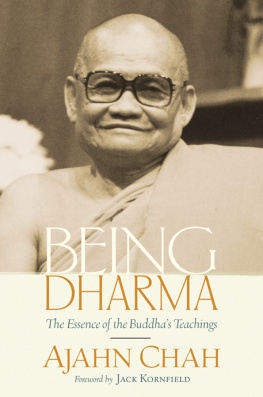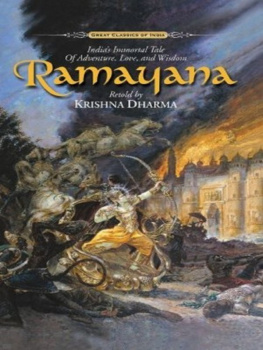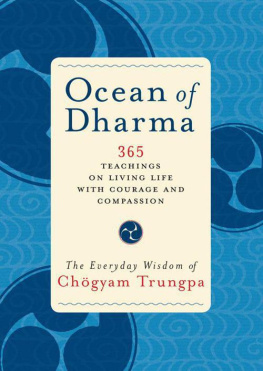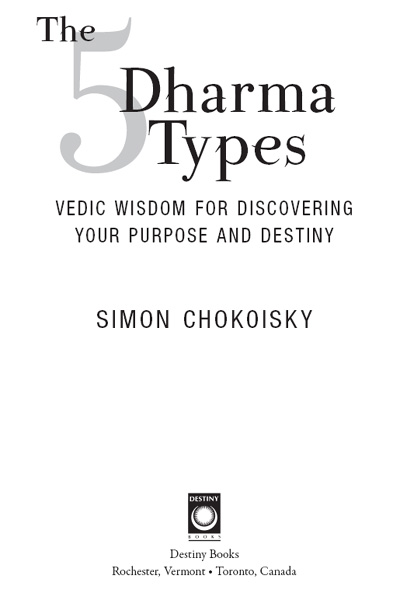This work has opened doors of insight and perception, allowing me to see our species in a fresh and hopeful light. I hope people will read this book more than once, and slowly.

My grateful acknowledgment to Mantriji,
Dr. Vasant Lad, Hart de Fouw, and all keepers ofancient wisdom the world over.
Special thanks to my wife, Ventzi, for her love and support, without which this book would never have come to fruition!
Preface
This work is a practical manual intended to help you attain fulfillment in your personal, social, and spiritual life. It is not a treatise on religion, philosophy, or academics, all of which offer relative truths to a specific culture, age, and environment. Instead, it is distilled from all of the above to present universal truths pertinent to humanity in the modern age. In todays global society, where humankinds understanding of reality is muddled by distinctions of race, color, and creed, it is ever so difficult to find ones place. The mundane world is a cacophony of sound, and the song of the spirit is difficult to discern for the multitude of contrary voices pulling us this way and that. This guide is intended to help you find your voice in the chorus of the many, and perhaps more importantly, to develop your ear that you may better hear and harmonize with the world about you. It is designed to help you know your purpose, and understand that of others, and by doing so to live in the world in a way envisioned by our most cherished prophets and mystics.
This book is best read in its entirety, as you will discover things about your dharma type, as well as those of others in your life, by reading even the sections that dont appear to apply directly to you. Reading only those parts that reference your type will prevent you from fully integrating it, as we must understand all five types in a symbiotic system that mirrors Nature, where one entity feeds another, which feeds the first in turn.
When each of us fulfills our destiny we empower others to do the same, and when they fulfill their destinies we are benefited in turn. This is the basis for mutual respect, sharing, and responsibilitythe foundations that pave the way to wisdom. May this be a useful guide to such wisdom and of service to all who use it!
Note to the Reader on the Use of Sanskrit Terms
This book is not a translation but an original work that makes use of Sanskrit terms with no real English equivalents. Where appropriate these have been plainly spelled out rather than transliterated. This is for two reasons. First, readers new to the material may find it cumbersome to decipher transliterations along with the plethora of new vocabulary and concepts. Second, readers who are already familiar with diacritical marks or even conversant in Sanskrit should know the proper spelling and pronunciation of these words. Thus, no great need is served by introducing transliteration here.
Introduction and Self Tests
Dharma kshetre Kuru kshetre... it was customary to open an important work with an auspicious word that served both to set the tone as well as to give readers an idea of its content. With dharma at its fore we can understand the Gita to be a treatise on purpose, duty, and Natural Law. Dharma is also the subject of this book. In the West we are familiar with terms like karma, but there is less understanding of dharma, our purpose in the world. Life without purpose is meaningless. Our modern Merchant society tries to provide meaning by giving us wealth and possessions to strive after, but material things cannot answer those most basic questions: Who am I? and Why am I here? Material objects can sustain us on our quest, but what we have come to do remains a mystery.
The Gita tells us that we must embrace dharma, our purpose, in order to find happiness in life. But how can we do this if we do not know what our purpose is? How are we to walk the path of fulfillment without a map to show us the way?
It is the role of society to organize people in such a way as to foster their optimal self-expression. Over the last several thousand years humankind has tried to invent and reinvent social structures that befit the free expression of our destinies, but our inventions are limited in scope and knowledge. As Paul writes in Corinthians, We know in part and we prophesy in part. What is needed is something that addresses our core essence to align us with the Natural Laws of the universe. Myth and archetypes do that very thing.
That which is beyond even the concept of reality, that whichtranscends all thoughtthe myth puts you there all the time, givesyou a line to connect with that mystery which you are.
JOSEPH CAMPBELL, THE POWER OF MYTH
If you do not think that myths are important, consider that we pour ourselves into mythic molds every day without realizing it. Fashion, movies, sports, family, and social dynamics all furnish different identities, casting us into roles like boss, parent, chic girl, or Lakers fan, thereby affecting how we behave and what we expect from life. But most of these roles are poor complements to the fullness of who we really are. The dharma types, on the other hand, are personal myths that have existed since time immemorial and will continue to be useful so long as humankind exists because they are the unseen matrices that guide how human beings express their destinies. Though invisible, their effects can be readily determined: a Warrior behaves like a Warrior and a Merchant like a Merchant in organized, predictable patterns.
MATTER AND SPIRIT
A persons archetype is like an operating system, the internal software that runs a computer. Regardless of the color, size, or manufacture date of its hardware it is the OS that gives a computer its most basic expression and instructs it to work. Likewise, the dharma type informs every human being regardless of race, sex, age, or nationality. In this book we shall consider five dharma types, or operating systems, and how they affect us in specific ways. To get the most out of the systems we were born with we must become familiar with how they work. To that end, this is an instruction manual detailing the inner workings of each type in practically every area of life, from how to maintain health to how to make money.
The dharma types are Individual Archetypal Myths, the I AM identity inside that guides each of us in subtle but definitive patterns. Today we associate the word myth with something unreal or untrue, but to our ancestors, myths spoke to an enduring truth that lay beyond the ken of the senses. Consider that our everyday world is in perpetual fluxcoming into being, changing form, and dying. In Sanskrit, the ancient language of India, this was termed samsara, constant movement, constant change. But myth is eternal, driven by the intelligent blueprint that underlies the mundane world of name and form.
Our ancient ancestors thought in mythic terms not because they were primitive, but because in many ways they were advanced. They understood that what would survive their bodies, societies, and even civilizations was made not of earth and stone but of something more subtle and permanent. Their personal myths helped them to find purpose and obtain an everlasting life beyond the parenthetical existence of the human body. The dharma types are alive today even as they lived 5,000 years ago, here for us to access if we only know how.



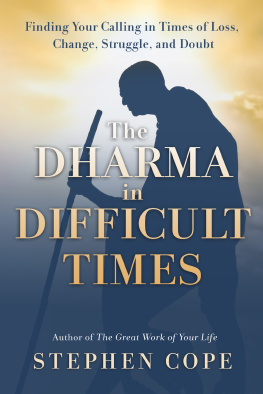

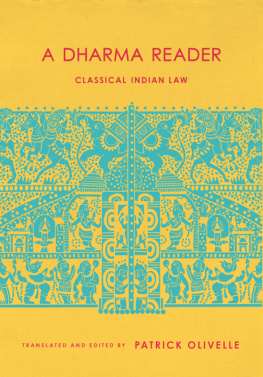
![Krishna Dharma - Mahabharata: [the greatest spiritual epic of all time]](/uploads/posts/book/213378/thumbs/krishna-dharma-mahabharata-the-greatest.jpg)
